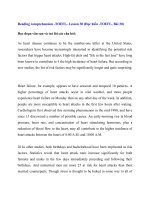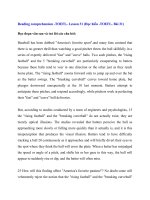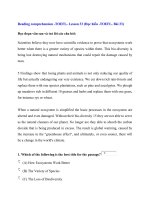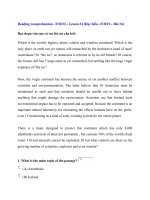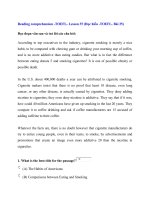Tài liệu Đọc hiểu -TOEFL- Bài 32 pot
Bạn đang xem bản rút gọn của tài liệu. Xem và tải ngay bản đầy đủ của tài liệu tại đây (76.23 KB, 5 trang )
Reading comprehension -TOEFL- Lesson 32 (Đọc hiểu -TOEFL- Bài 32)
Đọc đoạn văn sau và trả lời các câu hỏi:
The Timber rattlesnake, once widespread throughout the eastern United States, is
now on the endangered species list and is extinct in two eastern states in which it
once thrived. Compared to its western cousins, the Timber rattlesnake may be
especially vulnerable because 5 of certain behaviors adapted for coping with the
cold climate in which it lives.
Rattlesnakes are generally found in warm climates because, like all reptiles, they
cannot generate or regulate their own body temperature 10 internally and must rely
on the sun's warmth for heat. But Timber rattlesnakes migrated into colder northern
areas about 8,000 years ago when glaciers retreated. In these northern regions, the
snakes developed a number of adaptive strategies to survive, but ultimately these
behaviors make them more vulnerable to human predation, their 15 main threat.
One survival strategy the snakes have developed is hibernation. For approximately
eight months of the year, the rattlers remain motionless in deep frost-free crevices,
with their body temperature dropping 20 as low as 40 degrees. In the spring when
they emerge, they must warm their chilled bodies by sunning for three or four days
on rocks in the open. This behavior, coupled with the fact that Timber rattlesnakes
tend to concentrate in large numbers at their wintering sites, makes them easy prey.
Gestating females are particularly vulnerable because 25 they spend much of their
time basking in the sun in order to produce live young from eggs. In addition,
females have very long interbirth intervals, producing live young only every three
to five years. If a frost or cold spell comes late in the year, the entire litter of six to
twelve young may die.
30 Efforts are underway to protect the Timber rattlesnake and its habitat from
further human depredation, but in many states it is already too late.
1. What is the main topic of the passage?
(A) why Timber rattlesnakes hibernate
(B) how Timber rattlesnakes are surviving
(C) how Timber rattlesnakes adapted to northern climates
(D) why Timber rattlesnakes are endangered
2. Which of the following is closest in meaning to the word "vulnerable" in
line 4?
(A) unprotected
(B) impervious
D
A
(C) insensitive
(D) deprived
3. Which of the following is true about Timber rattlesnakes?
(A) They migrated to eastern states.
(B) They migrated northward during a warming period.
(C) They migrated to escape a cold climate.
(D) They migrated to the South to seek a warmer climate.
4. In line 19, the word "crevices" could be replaced by which of the following?
(A) tombs
(B) rocks
B
C
(C) cracks
(D) tunnels
5. Which of the following could best replace the word "emerge" in line 20?
(A) come out
(B) set off
(C) get up
(D) see through
6. In which of the following places might a person be most likely to find
Timber rattlesnakes in the spring?
(A) in the woods
(B) in meadows
A
B
(C) in bushy areas
(D) in canyons
7. Which of the following could best replace the phrase "coupled with" in line
22?
(A) compared with
(B) combined with
(C) controlled with
(D) supported with
8. The phrase "easy prey" in line 24 could best be replaced by which of the
following?
(A) relaxed
(B) protective
B
C
(C) victims
(D) sociable
9. Which of the following words can best replace the word "basking" in line
25?
(A) washing
(B) eating
(C) sleeping
(D) lying
10. According to the passage, which of the following does NOT contribute to
the rattlesnake being an endangered animal?
(A) hibernating for eight months
(B) basking in the sun
D
A
(C) congregating together
(D) having long intervals between births
11. Which of the following could best replace the word "depredation" in line
32?
(A) fear
(B) habitation
(C) destruction
(D) depression
12. What is the author's tone attitude toward the topic?
(A) accusative
(B) nostalgic
C
C
(C) regretful
(D) humorous




